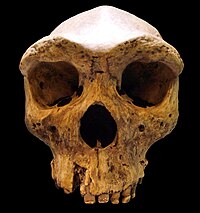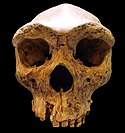Archaiczny Homo sapiens

Archaiczny Homo sapiens – nieściśle zdefiniowane pojęcie używane do opisania różnych Homo, przeciwstawianych ludziom anatomicznie współczesnym (Homo sapiens sapiens), w okresie zaczynającym się 500 000 lat temu. Do grupy tej zalicza się Homo heidelbergensis, Homo rhodesiensis, Homo antecessor, Homo helmei i Homo neanderthalensis (jako późny archaiczny Homo sapiens)[1][2].
Przypisy
- ↑ Archaic homo sapiens. W: Dawkins: The Ancestors Tale. Boston: Mariner, 2005. ISBN 0-618-61916-X.Sprawdź autora:1.
- ↑ EARLY AND LATE "ARCHAIC" HOMO SAPIENS AND "ANATOMICALLY MODERN" HOMO SAPIENS. [dostęp 2010-04-04]. [zarchiwizowane z tego adresu (2009-08-16)].
Linki zewnętrzne
- Origins of Modern Humans: Multiregional or Out of Africa?
- Homo sapiens, Museum of Natural History. mnsu.edu. [zarchiwizowane z tego adresu (2009-07-09)].
Media użyte na tej stronie
Autor: High Contrast, Licencja: CC BY 3.0 de
Anthroplogy - human skull of a boy. The skull is of a boy that was likely about 8 years old. The age of the skull itself is not known. Note the mandibular central incisors breaking through.
(c) Oryctes, CC BY-SA 3.0
Cast of the Sahelanthropus tchadensis holotype cranium TM 266-01-060-1, dubbed Toumaï, in facio-lateral view.
Autor: Thomas Roche from San Francisco, USA, Licencja: CC BY-SA 2.0
Homo erectus, Museum of Natural History, Ann Arbor, Michigan, November 2007.
Autor: Autor nie został podany w rozpoznawalny automatycznie sposób. Założono, że to Alberto Salguero (w oparciu o szablon praw autorskich)., Licencja: CC-BY-SA-3.0
Pablo Alberto Salguero Quiles
Autor: Gerbil, Licencja: CC-BY-SA-3.0
"Broken Hill Skull" from Kabwe, Zambia (replica, Museum Mauer, near Heidelberg, Germany). Type specimen of Homo rhodesiensis, renamed as Homo erectus, also sometimes named Homo heidelbergensis or "archaic Homo sapiens".






